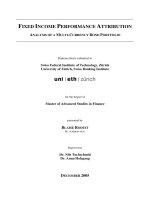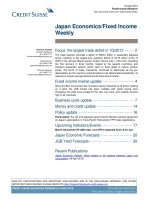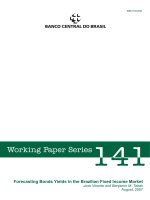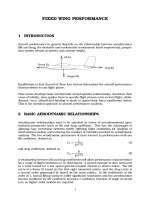fixed income performance attribution
Bạn đang xem bản rút gọn của tài liệu. Xem và tải ngay bản đầy đủ của tài liệu tại đây (813.06 KB, 56 trang )
F
IXED
I
NCOME
P
ERFORMANCE
A
TTRIBUTION
A
NALYSIS OF A
M
ULTI
-C
URRENCY
B
OND
P
ORTFOLIO
Diploma thesis submitted to
Swiss Federal Institute of Technology, Zürich
University of Zürich, Swiss Banking Institute
for the degree of
Master of Advanced Studies in Finance
presented by
B
LAISE
R
ODUIT
lic. sciences éco.
Supervisors
Dr. Nils Tuchschmid
Dr. Anna Holzgang
D
ECEMBER
2005
A
BSTRACT
- I -
Abstract
The two key asset classes available to investment managers are equities and bonds. Equity
attribution has been around for a while and well-established methods of attribution have been
developed. It is therefore tempting to generalize these methods to fixed income attribution.
However, in doing this the performance analyst ignores essential characteristics of fixed
income investments. In many points, risk factors in fixed income investments are
fundamentally different from those in equity. Some of them do not even have an equivalent in
the equity attribution universe – these include yield curves and credit spreads. Furthermore,
the effect of yield curve moves and spread changes on bond value is non-trivial. This paper
proposes in the first part to review the different factor decompositions and methodologies
used in the fixed income industry. A special emphasis is put on the yield curve shift effects
(parallel, twist, butterfly, reshape) which play a central role in performance attribution. In the
second part we discuss the practical problems of data quality that usually occur when
implementing a fixed income performance attribution. Then we will run a Fixed Income
Performance Attribution analysis (FIPA) on a real portfolio and interpret the results obtained.
We finish by checking which FIPA factors are the main driver of excess returns and if excess
returns identified are still present under a risk-adjusted basis.
F
IXED
I
NCOME
P
ERFORMANCE
A
TTRIBUTION
- II -
C
ONTENTS
1. Introduction..........................................................................................................................1
1.1. Performance attribution...................................................................................................1
1.2. Fixed income performance attribution............................................................................1
2. Theoretical framework........................................................................................................2
2.1. Fixed income return decomposition................................................................................ 2
2.1.1. Carry return – Coupon income.................................................................................2
2.1.2. Carry return - Roll-down..........................................................................................3
2.1.3. Market return – Yield curve.....................................................................................4
2.1.4. Market return – Spread.............................................................................................6
2.1.5. Market return – Volatility ........................................................................................6
2.1.6. Market return – FX rate............................................................................................7
2.1.7. Timing return............................................................................................................7
2.2. Yield curve construction .................................................................................................8
2.2.1. Yield to maturity (YTM) curve................................................................................ 8
2.2.2. Zero coupon yield curve...........................................................................................8
2.3. Yield curve decomposition............................................................................................10
2.3.1. Principal component analysis method.................................................................... 10
2.3.2. Empirical method................................................................................................... 13
2.3.3. Polynomial method ................................................................................................ 16
2.3.4. Duration based method...........................................................................................17
2.4. Linking return effects to multiple periods..................................................................... 18
2.4.1. The arithmetic model .............................................................................................18
2.4.2. The geometric model..............................................................................................19
3. Issues in practice................................................................................................................. 20
3.1. Data quality ...................................................................................................................21
3.1.1. Assets without price or with an incorrect price......................................................21
3.1.2. Corporate actions.................................................................................................... 21
3.2. Cash flows and management fees .................................................................................22
3.2.1. Management fees.................................................................................................... 22
3.2.2. Accounting of reclaimable withholding taxes........................................................22
3.2.3. Reinvestment of coupons .......................................................................................22
3.3. Gross / Net basis............................................................................................................22
3.4. Replicating the benchmark in general...........................................................................23
4. Characteristics of the portfolio analyzed......................................................................... 24
4.1. Constraints on the portfolio...........................................................................................24
4.2. Style of the portfolio manager.......................................................................................24
4.3. Set up of the fixed income performance analysis ......................................................... 25
4.3.1. The yield curve.......................................................................................................25
4.3.2. The YC decomposition factors...............................................................................26
4.3.3. Linking method ......................................................................................................26
5. The results........................................................................................................................... 27
5.1. The FIPA attribution for the global portfolio................................................................27
5.1.1. Global return (TWR)..............................................................................................28
5.1.2. Direct return ...........................................................................................................28
5.1.3. Roll-down...............................................................................................................28
C
ONTENTS
- III -
5.1.4. YC shift 1 (parallel shift) .......................................................................................29
5.1.5. YC reshape.............................................................................................................29
5.1.6. Sector spread return (credit spread) ....................................................................... 30
5.1.7. YC spread return (issue spread) ............................................................................. 31
5.1.8. Fixed income timing...............................................................................................31
5.1.9. Fixed income currency return ................................................................................ 32
5.2. The key ratios................................................................................................................32
5.2.1. The Alpha...............................................................................................................32
5.2.2. The Beta .................................................................................................................33
6. Interpretation .....................................................................................................................34
6.1. Excess returns and FIPA factors ...................................................................................34
6.1.1. Distribution of excess returns.................................................................................34
6.1.2. Interaction between FIPA factors and excess returns ............................................ 34
6.1.3. Multivariate analysis .............................................................................................. 37
6.2. Performance on a risk-adjusted basis............................................................................39
6.2.1. Alpha and FIPA factors.......................................................................................... 39
6.2.2. Excess returns on a risk-adjusted basis .................................................................. 40
7. Conclusion...........................................................................................................................44
8. Acknowledgments............................................................................................................... 46
9. References ........................................................................................................................... 47
10. Appendix ...........................................................................................................................48
Appendix 1: US government yield curve principal component analysis............................. 48
Appendix 2: Multivariate analysis of the FIPA factors........................................................49
I
NTRODUCTION
- 1 -
1.
I
NTRODUCTION
1.1. Performance attribution
A manager has a return of 8% for the year 2005 while the benchmark only performs 6%. How
did he get it? What could have caused an excess return of 2%? Hopefully it has something to
do with the manager’s conscious decisions. That is, with something the manager meant to do.
But, in reality, a whole lot of the return might have to do with things the manager didn’t do,
right? Like, the effects of the market at large. The economy. The overall movement of
industries relative to actions of the Federal Reserve or other bodies. Even some unintended
consequences of the manager’s actions! Performance attribution tries to answer these
questions.
The purpose of performance attribution is to understand realized excess returns and to relate
this information to the active decisions made in the investment organization, in order to
understand the sources of out-performance and identify the active decisions that have
generated the excess returns. Attribution models are designed to identify the relevant factors
that impact performance and to asses the contribution of each factor to the final result. This
information can then be communicated to clients, management and (not least) the portfolio
managers that conducted the active bets. In doing so the performance analysis can over time
add value by assisting in the identification of the investment management particular skills and
of the areas where skills appear to be lagging.
1.2. Fixed income performance attribution
The slump in equity markets during the last couple of years has changed many investors
attitude towards fixed income. From being a low returning low volatile asset class bond
investments are now considered more than just a safe-haven. Measured on a risk-adjusted
basis the long-term returns from bond investments compare favorably with equity returns.
In order to understand the active decisions made during the investment process it is essential
to understand the characteristics of the underlying asset classes and relevant risk factors that
drive the investments, since it is these assets classes and risk factors that the portfolio
manager analyzes when designing portfolios.
Two key asset classes available to investment managers are equity and bonds. Equity
attribution has been around for a while and well-established methods of attribution have been
developed. It is therefore tempting to generalize these methods to fixed income attribution.
However, in doing this the performance analyst ignores essential characteristics of fixed
income investments.
In many points, risk factors in fixed income investments are fundamentally different from
those in equity. Some of them do not even have an equivalent in the equity attribution
universe – these include yield curves and credit spreads. Furthermore, the effect of yield curve
moves and spread changes on bond value is non-trivial.
For all these reasons, Fixed Income Attribution has been one of the key challenges in the
portfolio management industry; though there is now an extensive set of research into differing
methodologies, there is still no agreed industry standard.
F
IXED
I
NCOME
P
ERFORMANCE
A
TTRIBUTION
- 2 -
This paper proposes in its first part to review the different factor decompositions and
methodologies used in the fixed income industry. A special emphasis is put on the yield curve
shift effects (parallel, twist, butterfly, reshape) which play a central role in performance
attribution. In the second part we will discuss briefly the different problems that usually occur
in practice when implementing the attribution. Then we will run a Fixed Income Performance
Attribution analysis (FIPA) on a real portfolio and interpret the results obtained. We finish by
checking which FIPA factors are the main driver of excess returns and if the excess returns
identified are still present under a risk-adjusted basis.
2.
T
HEORETICAL FRAMEWORK
2.1. Fixed income return decomposition
It is generally admitted that the value generated by holding bonds is composed of three
different components. Unlike the case for equities, the return generated from periodic cash
flows is significant. In addition to the periodic return, bond returns are sensitive to changes in
the fundamental market variables or fixed income risk factors. Finally the return is affected by
timing of trades. These three different sources of return are usually denoted by carry, market
and timing return:
TimingMarketCarryTotal
rrrr ++=
Fig. 1. Fixed income return components
2.1.1. Carry return – Coupon income
The carry return is composed of two components. The central component is the (typically
annual) coupon being paid out to the investor – we denote this component direct return. This
component is always positive. This direct return is theoretically defined as:
T
HEORETICAL FRAMEWORK
- 3 -
ty
P
tC
r
Current
∆⋅=
∆⋅
=
Direct
where C is the annual coupon, t is time passed, P is the initial price and y denotes yield.
More generally a direct return is computed as follows within a “end of the day cash-flow /
geometric model”:
()
( )
()
∑
∑
−−−−
−−−
−
⋅+⋅
⋅++⋅
=
1111
1
Coupon
11
Direct
,1
tttt
ttttt
tt
XAIPN
XCAIPN
r
where t: time, N: nominal amount, AI: accrued interest, P: price, C: coupon, X: FX rate.
Coupons
1 days interest earned
Redemption
+ Coupon
Coupons
1 days interest earned
Redemption
+ Coupon
Fig. 2. Direct return
2.1.2. Carry return - Roll-down
A less pronounced component of carry is the passage of time. Bonds usually do not trade at
par, but they are eventually redeemed at par, therefore at maturity the market price must
converge towards par. For longer-dated bonds this effect is minor, whereas it can be
significant for shorter-dated bonds trading away from par. This return component is called
roll-down return. The effect is positive for discount bonds (the roll effect will pull the price
up towards par) and negative for premium bonds (the roll effect will pull the price down
towards par).
The roll-down return can be interpreted as:
()( )
( )
()
()
∑
∑
−−−−
−−−−−
−
⋅++⋅
⋅++⋅
=
1
Coupon
111
1
Coupon
1111
RollDown
,1
,
ttttt
ttttttt
tt
XCAIPN
XCAIYCSYCPN
r
where t: time, N: nominal amount, P: price, X: FX rate, YC: yield curve, YCS: yield curve
spread.
Remark: The artificial price “P
t
(.)” is calculated by a function of different factors like yield
curve, yield curve spread, volatility for example (the number of factors depends on the model
complexity). Artificial prices are needed to sequentially calculate and decompose return
effects (see Fig. 1.).
F
IXED
I
NCOME
P
ERFORMANCE
A
TTRIBUTION
- 4 -
YC
t-1
Time
Zero rate
1 Day
YC
t-1
Time
Zero rate
YC
t-1
Time
Zero rate
1 Day
YC
t-1
Time
Zero rate
1 Day
YC
t-1
Time
Zero rate
YC
t-1
Time
Zero rate
1 Day
Fig. 3. Roll-down return when the bond is overvalued
2.1.3. Market return – Yield curve
In contrast to the carry return components the market return is less predictable. The market
return is driven by the market variables on which bond value depends. In fixed income the
yield curve is the central market variable. Traditionally the yield curve is based on bonds
issued by government entities. The rationale has been that this provides a default free yield
curve per country. Therefore the market value of government bonds are normally driven
entirely by movements in this curve.
The basic approach to modeling yield curve movements is to calculate the difference between
the final and the initial yield curve for the period for which performance is measured.
Fig. 4. Yield curve movements
Often portfolio managers decompose yield curve shifts further into basic movements.
Typically the number of basic movements vary between 2 and 5. This number is arbitrarily
chosen by the portfolio manager who constructed the portfolio and who did bets on yield
curve moves. The number of basic movements is consequently a trade-off between the
explanation power of the model and the complexity of the interpretation.
Recent studies suggest that most of the yield curve shift can be explained pretty well by
essentially three factors: parallel shift, slope (or twist) and curvature (or butterfly). The
unexplained shift left is normally statistically small and put in a residual factor called reshape.
T
HEORETICAL FRAMEWORK
- 5 -
Of course in market crisis situations these three first factors might be insufficient to leave the
reshape small and to do a good performance attribution.
a) Parallel shift
A parallel shift appears when the rates at standard maturities move uniformly. Note that
parallel shifts in yields are captured directly by the bond duration as
ParallelParallel
ycDr ∆⋅−≅
where r denotes return, D is modified duration and YC is the yield curve.
b) Twist (steeping / flattening)
We can see a twist effect when short term and long term rates move in opposite direction but
proportionately in relation to the distance from some “pivot point” maturity (usually defined
at 5 years).
c) Curvature
The curvature or butterfly effect occurs when short term and long term rates move in same
direction while medium term rates move in an opposite direction, still proportionately.
By decomposing the yield curve movements into contributions from these shifts the bond
fixed income portfolio return that is due to the yield curve moves can be decomposed into:
ReshapeCurvatureTwistParallelYieldCurve
rrrrr +++=
Fig. 5. Example of parallel, slope (steepness) and curvature shifts
The financial literature identifies several methods to extract these factors and quantify them.
Four, at least, can be mentioned:
F
IXED
I
NCOME
P
ERFORMANCE
A
TTRIBUTION
- 6 -
• Statistical Principal Component Analysis (PCA)
• Empirically constructed user-defined factors
• Polynomial fit mimicking a Taylor decomposition of the yield curve function
• Factor model based on duration analysis.
As the returns that are generated by the yield curve shifts are the heart of a fixed income
attribution analysis, we are going to review these four methods in detail a bit later in the
paper.
2.1.4. Market return – Spread
In addition to the general yield levels, non-sovereign debt is also sensitive to credit risk. The
market measure of credit risk is the spread. This is the additional yield that an investor will
require in order to invest in such bonds. The Implied Yield Curve Spread (YCS), which is the
discounting spread necessary to add to the yield curve in order to match the market price of
the given bond. So the YCS of a bond is the solution to the equation:
()
∑
++
=
t
t
t
YCSy
C
V
)1
where C
t
denotes cash flow at time t, V the value of the bond and y
t
is the zero yield for time t.
The return resulting from the yield curve spread is fully defined by the following equation:
()( )
()()
∑
∑
−−−
−−
−
⋅+⋅
⋅+⋅
=+
111
11
YCS
,1
,,
,,
1
ttttttt
ttttttt
tt
XAIVolYCSYCPN
XAIVolYCSYCPN
r
where t: time, N: nominal amount, P: price, X: FX rate, YC: yield curve, YCS: yield curve
spread, Vol: volatility.
The magnitude of the spread reflects the credit quality of the issue. The spread is typically
decomposed into two subcategories – the sector spread (industry specifics and rating
specifics) and the issue spread (issuer specifics). The first subcategory reflects aspects
common across bonds issued by corporations with similar ratings and in similar industries;
the second category reflects issue/issuer specific considerations. Therefore the spread can be
decomposed as:
IssueSectorSpread
rrr +=
The spread return component is a market return. Typically sector spreads vary substantially
over time and the spread return can be sizeable - also in comparison to curve returns. As an
example the contagious spread of the Russian credit crisis that occurred in the autumn of 1998
meant that increases in spreads were of the same magnitude as falls in government yields.
2.1.5. Market return – Volatility
For standard domestic bonds the previous factors are the main drivers. For more complex
instruments other market variables can add value. An important category of bonds is bonds
T
HEORETICAL FRAMEWORK
- 7 -
with embedded options. Often asset-backed, mortgage-backed and corporate bonds have
built-in options in the form of put, call or prepayment options. For such bonds changes to
implied volatility is an important factor behind market value, since the volatility drives the
option value. For most vanilla bond portfolios the volatility return is small compared to the
direct, curve and spread return components. However for portfolios with large options
positions or many mortgage bonds the volatility effect can be significant.
Volatility is computed as follows:
()()
( )
()()
()
∑
∑
−−−−
−−−−
−
⋅++⋅
⋅++⋅
=+
1
Coupon
111
1
Coupon
111
Vol
,1
,
,,
1
ttttttt
tttttttt
tt
XCAIYCSYCPN
XCAIVolYCSYCPN
r
where t: time, N: nominal amount, P: price, C: coupon, X: FX rate, YC: yield curve, YCS:
yield curve spread, Vol: volatility.
2.1.6. Market return – FX rate
For foreign investments the FX rate development is another key risk factor that impacts the
performance. The currency effect is generic (not specific to fixed income) and it is treated
exactly as for equity portfolios.
The FX effect is calculated with:
( )
( )
()
()
∑
∑
−
−
⋅++⋅
⋅++⋅
=+
1
Coupon
Coupon
Currency
,1
1
ttttt
ttttt
tt
XCAIPN
XCAIPN
r
where t: time, N: nominal amount, P: price, C: coupon, X: FX rate.
2.1.7. Timing return
Timing return component arises due to the trading activities in a portfolio. Performance
measurement is typically done based on end of day prices. Usually trading is conducted
during the trading hours and therefore some discrepancy will occur. The effect of this trading
is compounded into the timing return component. In case the trader has executed on attractive
levels relative to end of day pricing the effect will show up as a positive return component.
Timing return can be defined as:
()
( )
()()
()
∑
∑
−−−
−
−
⋅++⋅
⋅++⋅
=+
1
Coupon
1,1
1
Coupon
Timing
,1
,
1
tttttttt
ttttt
tt
XCAIVolYCSYCPN
XCAIPN
r
where t: time, N: nominal amount, P: price, C: coupon, X: FX rate, YC: yield curve, YCS:
yield curve spread, Vol: volatility.
Note that in this section 2.1. all formulas come from an “end of the day cash-flow / geometric
model”. The formulas change a bit if we are in a “beginning of the day and/or arithmetic”
F
IXED
I
NCOME
P
ERFORMANCE
A
TTRIBUTION
- 8 -
setting. However the logic behind remains the same. This concludes the study of fixed income
return decomposition as described in Fig. 1. The following section is dedicated to the most
important component for fixed income attribution – the yield curve effect.
2.2. Yield curve construction
The yield curves are extracted from bonds available on the markets. Basically there are two
main types of yield curves - the yield to maturity curve and the zero coupon yield curve. The
zero coupon yield curve is easier to model than the YTM curve. Therefore a consequent
amount of academic research has been done on the zero coupon yield curve where maybe the
most well known model is the stochastic model of Vasicek.
2.2.1. Yield to maturity (YTM) curve
The yield to maturity (YTM) curve is computed with the yield to maturity, which is a
security’s internal rate of return, or the anticipated yield of the bond if held to maturity. The
YTM is the rate used when calculating the present value of all cash flows, so that they add up
to the current market price. In other words, it is the compounded rate of return that investors
receive if the bond is held to maturity and all cash flows are reinvested at the same rate of
interest. If r is the current yield to maturity, then a bond price is given by:
() () () ( )
PrBrCrCrC
nn
=++++++++
−−−−
11...11
21
where C is an annual coupon, n is the number of years to maturity, B is the par value of the
bond, P is the current market price of the bond.
2.2.2. Zero coupon yield curve
The zero coupon yield curve is computed with zero coupon yield, which is the return it would
show if all coupons were stripped out. Note that for securities that do not pay coupons, such
as zero-coupon bonds or bills, there is only one repayment cash flow at maturity. In this case,
the yield to maturity is identical to the zero coupon yield.
Thanks to its simplicity a lot of evaluation methods have been developed for the zero coupon
yield curve. The following list is not exhaustive:
• Bootstrapping
• Cubic spline
• Nelson Siegel
• Cox Ingersoll Ross
• Cox Ingersoll Ross (inflation)
• Vasicek
• Longstaff Schwartz
• Maximum smoothness
• Natural spline
T
HEORETICAL FRAMEWORK
- 9 -
The evaluation principles may be divided into three groups: bootstrapping methods,
mathematical methods and term structure models.
For all models, except the bootstrapping method, the underlying functional form is estimated
using ordinary least squares. Therefore, theoretical and observed prices on the bonds, which
have provided data for the yield curve will usually deviate. On the other hand, in the
bootstrapping method theoretical and observed prices on the bonds that have provided data
for the yield curve are always equal due to the calculation principle.
In the bootstrapping method, the zero coupon yield curve is approximated using a continuous,
piece-wise linear, function. The number of pieces are equal to the number of bonds (or money
market, FRA/IRF and/or swap quotes) within the segment to provide data for the yield curve.
The break points are defined by the time to maturity of the bonds. Therefore, if the segment
includes 18 bonds, the yield curve is defined by 18 parameters, i.e. the slopes of the 18 linear
pieces.
With the mathematical methods (cubic spline, natural spline, Nelson spline), estimation
techniques are used to create yield curves. We invite the reader to refer to a statistical book
for further details
1
.
Finally an alternative is to use term structure models (Cox Ingersoll Ross, Cox Ingersoll Ross
[inflation], Vasicek, Longstaff Schwartz). They are descriptions of changes to interest rates
over time. Some of these models are characterized by having closed form solutions to the
price of zero bonds, which may be used in the yield curve estimation. Basically the
parameters in the interest rate process are used as variables in the estimation. By varying these
parameters, it is possible to find the process that fits the prices of the instruments used in the
estimation best. With theses approaches the interest rate models have good asymptotic
behavior (such as converging, as term to maturity is large) and sometimes the parameters may
have a financial interpretation. However, the approach is rather pragmatic. The models are
simply used to produce zero curves with ideal features and no further interpretation is
attempted.
Vasicek and Longstaff-Schwartz are somewhat more complex than the rest of the models. In
these models the zero coupon yield curve is approximated by an equation that is derived as a
solution to a stochastic differential equation. The change in interest rates is decomposed into a
drift term and a stochastic term. The Longstaff-Schwartz model even includes two stochastic
differential equations. In these models the underlying stochastic differential equations relate
to so called factors, which are presumed to describe the pricing in the financial market.
As an example we present here a brief model specification of the Vasicek model.
Vasicek model
2
The change in interest rates is modeled with a stochastic differential equation:
()
()
0
0
rr
dWdtrradr
t
=
+−=
σ
1
See for example [11] Knott G.D., “Interpolating cubic splines”, Birkhäuser, 2000
2
See for a complete specification [15] Vasicek O., “An equilibrium characterisation of the term structure”,
Journal of Financial Economics, 5: 177-187, 1977
F
IXED
I
NCOME
P
ERFORMANCE
A
TTRIBUTION
- 10 -
where r is the interest rate. The other parameters are defined as follows:
• a > 0 : speed of mean-reversion
•
r
> 0 : level of mean-reversion (the average value where the interest rate converges)
•
σ
> 0 : absolute volatility
•
t
W
: a standard Brownian motion at time t
Note that negative interest rates are possible with positive probability with these settings,
which is a weakness of the model.
The solution of the stochastic differential equation given above is for
ts <≤0
:
()
()
()()
()
()
∫
−−−−
+−+=
t
s
utasta
udWersrertr
σ
Given
s
F
, the filtration at time s, r(t) is normally distributed with mean and variance:
()
[]
()
()()
()
[]
()
()
sta
s
sta
s
e
a
trVar
rsrertrE
−−
−−
−=
−+=
2
2
1
2
σ
F
F
The zero coupon yield curve can then be modeled with r(t).
For a more detailed discussion concerning the characteristics of these term structure models,
please refer to relevant financial literature covering these models
3
.
2.3. Yield curve decomposition
As we saw in the sections above, the yield curve can be decomposed in 3 main factors in
order to explain the global shift – the factors being the parallel shift, twist, butterfly, plus a
residual. Now we are going to review the four methods that people usually use in the industry
to decompose the yield shift. These methods are generally applied on zero coupon yield
curves.
2.3.1. Principal component analysis method
To explain all the possible distortions by using n maturity points to define the curve, n
scenarios on each yield curve are required. PCA is a coordinate transformation that reduces
the redundancy contained within the data by creating a new series of components in which the
axes of the new coordinate systems point in the direction of decreasing variance. The
resulting components are often more interpretable than the original images. The mean of the
original data is the origin of the transformed system with the transformed axes of each
component mutually orthogonal.
3
See for example [9] Hughston L., “Vasicek and Beyond: Approaches to Building and Applying Interest Rate Models”,
Risk Books, 1997
T
HEORETICAL FRAMEWORK
- 11 -
The methodology is as follows:
1. Import the interest rate series. For example daily yield curves of selected maturities up
to 30 years.
2. Compute the stationary series of differences.
3. Compute the eigenvalues and eigenvectors of the series. The eigenvectors represent
the factor loadings, while the eigenvalues represent the significance of the factors.
Eigenvalues are reported in descending order.
4. The relative weight of the eigenvalues gives the explanatory power of the various
factors.
5. The matrix of components is created. By construction because of orthogonality, the
components are mutually uncorrelated.
6. Every element of the original series can be reconstructed using the components and
the loading matrix.
7. As reported in the interest rate literature
4
, the three factors represent different aspects
of interest rate movements. Typically, the first factor is responsible for parallel shifts,
the second one for twist changes and the third one for butterfly adjustments.
Below you see a PCA analysis of the US Government yield curve. The time period chosen
goes from January 1997 to August 2005. We took monthly data. The Fig. 6. shows the
different indexes that compose the US Government yield curve (1 month, 3 months, 6
months, 9 months, 1 year, 2 years, 3 years, 5 years, 10 years and 30 years).
USD Govt Yield Curve Indexes
0
1
2
3
4
5
6
7
8
01/1997
05/1997
09/1997
01/1998
05/1998
09/1998
01/1999
05/1999
09/1999
01/2000
05/2000
09/2000
01/2001
05/2001
09/2001
01/2002
05/2002
09/2002
01/2003
05/2003
09/2003
01/2004
05/2004
09/2004
01/2005
05/2005
%
USD.INDEX.1M
USD.INDEX.3M
USD.INDEX.6M
USD.INDEX.9M
USD.INDEX.1Y
USD.INDEX.2Y
USD.INDEX.3Y
USD.INDEX.5Y
USD.INDEX.10Y
USD.INDEX.30Y
Fig. 6. Indexes that compose the USD Government yield curve from Jan. 1997 to August 2005
This period is particularly interesting to analyze because it encloses a yield curve reversion
(shorter rates higher than longer rates) from May 2000 to January 2001, then a steeping of the
curve for 2001 and finally a flattening from May 2004.
4
See for example [10] James J. & Webber N., “Interest Rate Modelling“, Ed. J. Wiley, 2001
F
IXED
I
NCOME
P
ERFORMANCE
A
TTRIBUTION
- 12 -
By applying a standard PCA
5
analysis, we obtain the following factor loadings and the
cumulative explained variance:
USD.INDEX.1M
USD.INDEX.3M
USD.INDEX.6M
USD.INDEX.9M
USD.INDEX.1Y
USD.INDEX.2Y
USD.INDEX.3Y
USD.INDEX.5Y
USD.INDEX.10Y
USD.INDEX.30Y
0.0 0.1 0.2 0.3 0.4
Factor 1 loadings
USD.INDEX. 1M
USD.INDEX. 3M
USD.INDEX. 6M
USD.INDEX. 9M
USD.INDEX.1Y
USD.INDEX.2Y
USD.INDEX.3Y
USD.INDEX.5Y
USD.IND EX. 1 0 Y
USD.IND EX. 3 0 Y
-0.2 0.0 0. 2 0. 4
Factor 2 loadings
USD.INDEX.1M
USD.INDEX.3M
USD.INDEX.6M
USD.INDEX.9M
USD.INDEX.1Y
USD.INDEX.2Y
USD.INDEX.3Y
USD.INDEX.5Y
USD.INDEX. 10Y
USD.INDEX. 30Y
-0.2 0.0 0.2 0.4
Factor 3 loadings
Fig. 7. Factor loadings of the first three principal components
0 5 10 15 20 25
F.1 F.2 F.3
Cumulative variance explained
Variances
0.971
0.995
0.999
Fig. 8. Cumulative variance explained by the first three factors
The factor loadings of the first principal component are as expected typically large and similar
for all variables. An upward shift in the first principal component therefore induces a roughly
parallel shift in all variables. For this reason the first principal component is called parallel
shift. With PCA method, the parallel component is not strictly speaking a translation of yield
returns but rather a level change impacting the short and long term slightly differently. Here
for example the shorter rates are proportionally less affected than the longer rates. The first
component explains here 97% of the variation during the data period in consideration.
5
The code is available in Appendix 1
T
HEORETICAL FRAMEWORK
- 13 -
In this example, an upward movement in the second principal component induces a change in
slope of the yield curve, where short maturities move up but long maturities move down with
an unchanged point at approximately 2 years. This second component is called twist and
explains about 2.5% of the variation.
The third principal component influences the convexity of the yield curve. The factor weights
are positive for the short rates, but decreasing and becoming negative for the medium term
rates and then increasing and becoming positive again for the longer maturities. This is the
butterfly effect. This effect explains 0.4% of the variation.
The unexplained variation (less than 0.1%) is sometimes called reshape and considered as the
residual of the PCA decomposition.
Note that the PCA method is a pure statistical decomposition and does not involve making
strong assumptions on the magnitude and direction of yield changes occurring on a given
period. The principal components are perfectly uncorrelated, making the performance
numbers attached to each curve effect additive and clearly definable and explain most of the
yield changes variance.
PCA does not require that functional form of the parallel, twist and butterfly are defined a
priori. We generally observe that the first component identified as the parallel shift is not even
over the term structure of the yield curve and shows more movement at the short end than the
long end. However a method exists to force the first component to be strictly parallel by
reprocessing the components to orthogonalize them.
Furthermore, we still have to make assumptions on the horizon length. There is a fine line
between statistical data relevance and explanatory relevance. Statistically speaking, the longer
the horizon the better, however the changes in yield curve shape from a past period may be
less relevant than recent events. For a performance attribution, a time window of 3 months
seems to be appropriate.
2.3.2. Empirical method
The empirical method decomposes returns of the portfolio in a very similar manner to the
PCA method. The difference is that instead of using a statistical analysis to define the parallel,
twist and butterfly components, changes in zero-coupon yield at the beginning and end
periods are measured empirically. It consists in a decomposition of the yield curve changes
into a combination of three basic components: parallel, twist and butterfly.
Unlike the PCA, the components are not statistically determined through a set of axis
rotations in the spot rates, but rather by an empirical analysis of the yield curve. A method
developed by Lehman brothers
6
uses a piecewise function with 5 maturity points on the yield
curve (2, 3, 5, 10, 30 years), the pivot point being at 5 years.
6
See: [5] Dynkin L., Hyman J. & Konstantinovsky V., “A return Attribution Model for Fixed Income Securities”, Handbook
of Portfolio Management, 1998
F
IXED
I
NCOME
P
ERFORMANCE
A
TTRIBUTION
- 14 -
The method used by Lehman brothers is:
1. First define the beginning and end of the period and compute the changes in zero-
coupon yields between those two dates for the five reference maturities.
2. The three piecewise functions for parallel, twist and butterfly are defined:
• Parallel shift called p is intuitively set to equal the average yield changes over the
five references maturities:
()
3010532
5
1
yyyyyp ∆+∆+∆+∆+∆=
• Twist returns are defined with a pivot point set at the 5-year maturity point. The 5-
year point is consequently not affected by the twist change. The twist magnitude is
defined as:
230
yyt ∆−∆=
t is applied such as the 30-year moves up by t/2 and the 2-year point moves down
by t/2 too.
• Butterfly returns is defined as:
()
5302
2
1
yyyb ∆−∆+∆=
b is applied such as the 2-year and 30-year move up by b/3 and the 5-year point
moves down by 2b/3.
The empirical approach uses full revaluation. The results are very consistent across all
securities and the whole portfolio. It is also interesting to notice that the shape effect
(residual) is small, which means that the empirically defined curve distortions explain a very
important part of the returns. The flexibility of the empirical method allows the portfolio
manager to customize the attribution relatively to his bets. For example he can move the pivot
point to better match his investment positions. Such refinements are an open discussion that
can lead to more accurate measures of performance attribution.
One way to exploit at best this flexibility would be to calibrate the pivot point by using a
PCA. Hence we will keep the flexibility of the empirical method whilst leveraging the PCA to
describe the yield curve environment in a pertinent manner.
T
HEORETICAL FRAMEWORK
- 15 -
When the shift factors (parallel, twist, butterfly,...) are well defined, a factor loading is
computed:
⎟
⎟
⎟
⎟
⎟
⎠
⎞
⎜
⎜
⎜
⎜
⎜
⎝
⎛
⋅
⋅
+
⎟
⎟
⎟
⎟
⎟
⎠
⎞
⎜
⎜
⎜
⎜
⎜
⎝
⎛
⋅
⋅
++
⎟
⎟
⎟
⎟
⎟
⎠
⎞
⎜
⎜
⎜
⎜
⎜
⎝
⎛
⋅
⋅
+
⎟
⎟
⎟
⎟
⎟
⎠
⎞
⎜
⎜
⎜
⎜
⎜
⎝
⎛
⋅
⋅
=
⎟
⎟
⎟
⎟
⎟
⎠
⎞
⎜
⎜
⎜
⎜
⎜
⎝
⎛
⋅
⋅
−
−
N
N
N
N
t
t
N
t
t
R
R
F
F
I
F
F
I
YC
YC
YC
YC
1
5
1
5
5
1
1
1
1
1
1
1
1
...
Yield curve, t Yield Curve, t-1 Shift 1 Shift 5 Reshape (residual)
where N represents the number of maturity points, F the factors and I the factor loadings.
With these factor loadings we can therefore quantify the yield curve shift explained by each
factor. Two approaches are broadly used to define these loadings - the first is the sequential
OLS, the second one the standard OLS.
a) Sequential OLS
In the Sequential Ordinary Least Square procedure, the loadings are calculated for each factor
using simple algebra factor by factor. For example loading 1 is calculated by maximizing:
11
1,1
1
FF
YCF
I
T
tt
T
⋅
∆
=
−
where YC
t,t-1
is the total shift in the yield curve between time t-1 and time t, I the factor
loading and F the factor.
Once the first loading is calculated the next loading (I
2
) is computed by maximizing:
()
22
111,2
2
FF
FIYCF
I
T
tt
T
⋅
⋅−∆
=
−
This process continues until all loadings are calculated (sequential OLS), or the process stops
at the desired number of factors and the remaining unexplained yield curve shift is the
residual (reshape) change. The basic idea behind this method is that the first factor explains
the most yield curve variance as possible and leaves a residual. Then the second factor only
explains the residual as best as possible and gives another smaller residual and so on.
By analyzing factors loadings computed with a sequential OLS, we have to be careful because
a factor effect can offset another one. For example a yield curve shift can be partially offset
by a twist effect. However in practice, portfolio managers first think in term of duration (i.e. a
parallel shift) and then with a twist for example. Therefore, even though this method seems to
be mathematically less correct, it fits better the methodology of portfolio managers.
F
IXED
I
NCOME
P
ERFORMANCE
A
TTRIBUTION
- 16 -
b) Standard OLS
Alternatively all loadings can be calculated directly using an Ordinary Least Square
procedure. Here the vector of loadings is the maximized solution to the following problem:
[][ ]
Reshape111,
,...,,..., YCIIFFYC
T
nntt
∆+⋅=∆
−
where YC is the total shift in the yield curve between time t-1 and time t, I the factor loading
and F the factor.
Here all factors maximize the variance explained in one step. Mathematically this result is
optimal but less interpretable than the sequential OLS.
2.3.3. Polynomial method
The polynomial method does not involve a multi-dimensional statistical analysis, but rather
uses a more intuitive of extracting the zero, first and second order changes from polynomials
that fit the yield curve at the beginning and end of period and model the yield changes as the
difference between each polynomial of the same degree.
The polynomial approach relies on defining coefficients from fitting polynomials at the
beginning and end of the period and using them to estimate magnitude changes in the
portfolio yield.
The methodology:
1. Fit three polynomials respectively of degree zero, one and two to the yield curve at
the beginning and end of period and extract respectively three sets of polynomials:
( )
()()
()()()
End
2
Begin
2
End
1
Begin
1
End
0
Begin
0
End
1
Begin
1
End
0
Begin
0
End
0
Begin
0
,,,,,
,,,
,
γγγγγγ
ββββ
αα
2. Compute for each yield curve component the magnitude of change due to each
effect:
a. The parallel magnitude is defined as:
Begin
0
End
0
αα
−=p
b. The twist magnitude is defined as:
()
( ) ( )
tts ⋅−+−=
Begin
1
End
1
Begin
0
End
0
ββββ
T
HEORETICAL FRAMEWORK
- 17 -
c. The butterfly magnitude is defined as:
()
( ) ( ) ( )
2Begin
2
End
2
Begin
1
End
1
Begin
0
End
0
tttb ⋅−+⋅−+−=
γγγγγγ
where t is the time period on the yield curve term structure.
These parameters are proxies for the parallel (p), twist (s) and butterfly (b) effects at each
maturity point of the zero-coupon yield curve.
In practice, relying on zero-degree polynomials to measure the parallel shift effects leads to a
poor outcome and a minuscule attribution of the return to the parallel component. This
method attributes returns mainly to the twist and more predominantly to the residual,
emphasizing a redundancy or double-counting.
To explain these deficiencies of the polynomial decomposition we have to understand that
every one of the polynomial fits is independent from the others and explains as much of the
variance as possible in a non-orthogonal space. We understand then that without a correlation
effect correction an over-estimation of the total return and a disproportionate residual is
obtained.
The only applicable way to use this method is to measure the parallel shift with the empirical
method and then apply the first order polynomial for the twist and the second-order
polynomial for the butterfly. This sequential attribution will ensure that parallel shift explains
most of the return.
2.3.4. Duration based method
The duration approach decomposes returns of the portfolio based on its yield, duration and
convexity. The calculation can be applied at every level of the portfolio and is very intuitive
and easy to implement.
Following the method detailed in Fong
7
, the duration method breaks down the yield curve
movement using the duration and convexity measures. The duration component explains the
parallel effect and the convexity component captures the twist.
The parallel shift can be simply calculated as follows:
RD ∆⋅−=∆
Parallel
where R is the change in zero-coupon yield from the beginning of period to the end of period
and D is the modified duration.
Similarly, the twist effect is measured as the second order term of a Taylor expansion:
7
See [8] Fong G., Yoo D., & Zelaya Z.M., “Global Performance Attribution, Perspectives on International Fixed Income
Investing”, 1998
F
IXED
I
NCOME
P
ERFORMANCE
A
TTRIBUTION
- 18 -
2
Twist
2
1
RC
i
∆⋅=∆
where C is the effective convexity.
The advantage of the duration approach is that it does not require the definition of terms and
conditions of securities. Secondly portfolio managers and traders have the intuition for YTM,
duration and convexity values, as these measures are widely accepted and used in fixed
income analytics.
The key assumption is that the distributed cash flows of a fixed income instrument are
approximated by a concentrated cash flow at the duration of the security. Consequently this
method may not work well with a bond featuring big distributed cash flows scattered about
the full term structure.
2.4. Linking return effects to multiple periods
Two broadly used methods are available to link returns over multiple time period: the
geometric model and the arithmetic model.
8
2.4.1. The arithmetic model
In arithmetic attributions the daily excess return contribution is simply obtained by addition of
the different factors:
∑
−−
=
i
tttt
rr
,1,1
where i is used as indicator for the factors, i={Direct, Roll-down, YC shift 1,…, Currency}
We can compound this return into multiple periods with:
( ) ( )
∏
∑
∏
−−
+=+=+
i
tttt
rrr
,1,1
111
Compounding will however result in cross products of the different return effects as it is not
possible to swap between sums and products. These cross products create residuals difficult to
attribute and interpret. Up to now, some methods have been developed to handle this problem.
For a complete description please refer for example to David Spaulding’s book. We can
shortly mention the most used methods:
• Arithmetic linking + a residual
• Geometric linking + a residual
• Logarithmic linking + a residual distributed along each effect with a repartition key
• Optimized approach (similar to the logarithmic one)
8
For a deeper analysis on multiple periods see [14] Spaulding D., “Investment Performance Attribution”, McGraw-Hill, 2003
T
HEORETICAL FRAMEWORK
- 19 -
From the unpublished white papers we read to write this thesis, it appears that many
attribution vendors typically use the geometric method to link the sub-period effects.
Geometric method has the merit to be simple and easy to comprehend.
2.4.2. The geometric model
Geometric attribution is not as “linking challenged” as arithmetic.
In geometric attributions the daily return contribution is obtained by multiplication and the
return can be decomposed as:
( )
∏
−−
+=+
i
tttt
rr
,1,1
11
where i is used as indicator for the factors, i={Direct, Roll-down, YC shift 1,…, Currency}
Compounding into multiple periods is really straight forward:
( ) ( )
∏∏∏
−−
+=+=+
i
tt
i
tt
rrr
,1,1
111
The big advantage of the geometric method is that it uses multiplication properties to link
return effects in multiple periods. This calculation is consequently very easy and without any
residuals. Other benefits of this method are the convertibility and proportionality properties:
a) Proportionality
One advantage to geometric excess return (relative to a benchmark) is that it takes into
consideration the magnitude of the individual returns. That is, it provides some dimension to
what is going on.
For example, let’s say our portfolio had a return of 11% versus a benchmark of 10%.
Arithmetically, we would have an excess return of 1%. Likewise, if our portfolio was 25%
versus 24% benchmark, we would show an excess return of 1%.
Geometrically, we get different numbers:
%991.01
110.0
111.0
=−
+
+
and
%81.01
124.0
125.0
=−
+
+
The differences occur because the 1% addition earned relative to 10% counts a whole lot
more than it does relative to 24%. Make sense?
b) Convertibility
Another benefit of the geometric approach is that it reports the same excess return, regardless
of the currency.
F
IXED
I
NCOME
P
ERFORMANCE
A
TTRIBUTION
- 20 -
For example, let’s say on January 1, our portfolio starts out at $100. On that date, the
conversion rate to Euro was 1.13305 (i.e. for $1, we get €1.13305). Our conversion to Pounds
Sterling is 0.696676 (i.e. for $1 we get roughly 69 pence).
Twelve months go by and our US portfolio has gone up 10%, to $110. The benchmark (in US
dollars) has gone up 8% during this time. The new FX rates are for Euro 1.18970 (i.e. for $1
we get €1.18970) and for Pounds Sterling 0.710610 (i.e. for 1$ we get £0.710610).
The following table shows the starting and ending values in the three currencies for thee
portfolio and benchmark. We also show the returns and excess returns.
Portfolio Index Portfolio Index Portfolio Index Arithmetic Geometric
US $
100.00 100.00 110.00 108.00 10.00% 8.00% 2.00% 1.85%
Euro 113.31 113.31 130.87 128.49 15.50% 13.40% 2.10% 1.85%
Pounds
69.67 69.67 78.17 76.75 12.20% 10.16% 2.04% 1.85%
Starting values Ending values Return Excess return
Fig. 9. Comparison of the arithmetic and geometric returns
For example, the geometric and arithmetic excess return for Euro is computed as:
%10.21340.01550.0
%85.11
1340.01
1550.01
,€
,€
=−=
=−
⎟
⎠
⎞
⎜
⎝
⎛
+
+
=
A
G
ER
ER
As the table shows, the arithmetic excess return varies from country to country because of the
exchange rate differences. The fact that the geometric excess return shows the same value
regardless of the exchange is considered an advantage, especially for firms that market
internationally.
With these words we are ending the theoretical parts of this master thesis. After having
reviewed the theoretical framework underlying a fixed income performance attribution we
would like to continue this thesis by describing shortly the different problems usually
encountered in practice.
3.
I
SSUES IN PRACTICE
To perform a fixed income performance attribution the entire portfolio has to be recalculated
each day in order to extract the different return effects. Furthermore, a decomposition is
typically done with subcategories like for example currency and maturity. Consequently index
benchmarks provided by the market are not sufficient, internal benchmarks on security level
have to be constructed as well to match each subcategory. These internal benchmarks have to
replicate exactly the index benchmark to which they depend.
We then understand that the IT system, price sources, price quality, cash out- and inflows
must be handled in a very rigorous way.
A good performance attribution without an excellent performance measurement is nothing!
Database maintenance is therefore the first obligatory step prior to any performance









